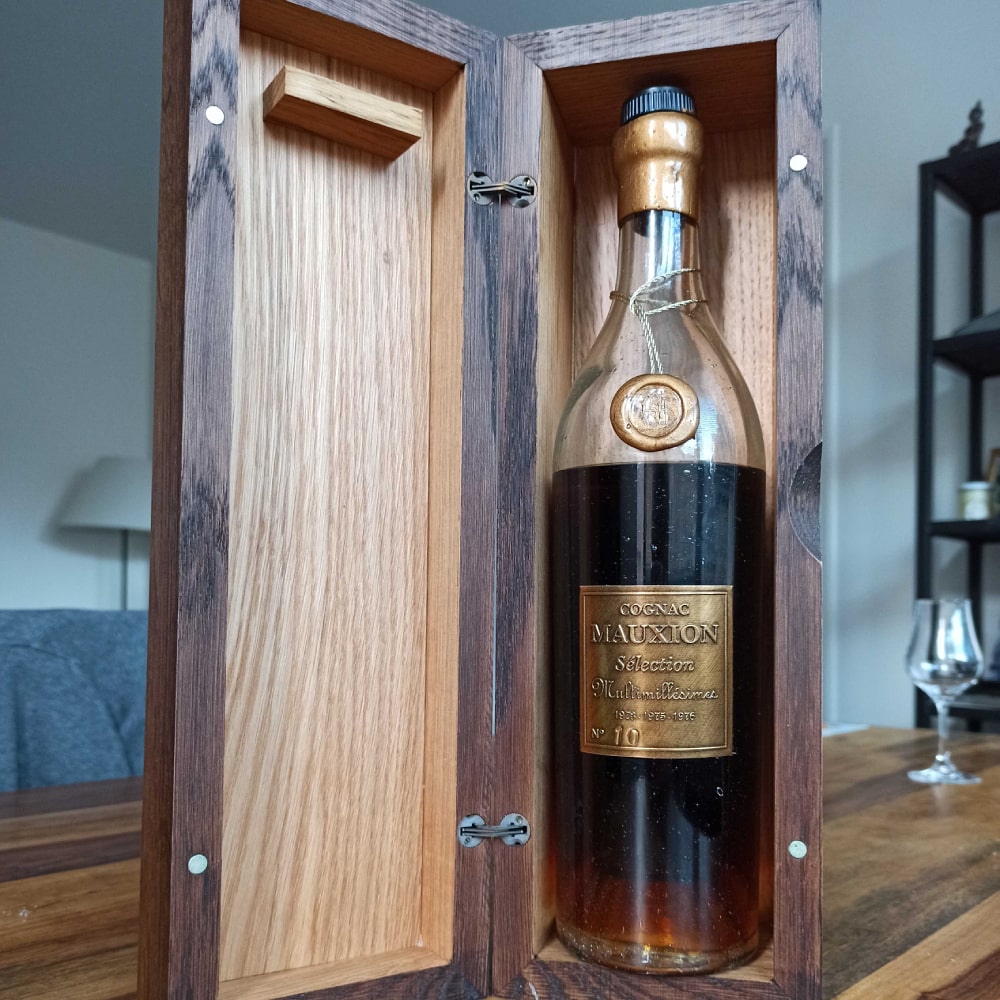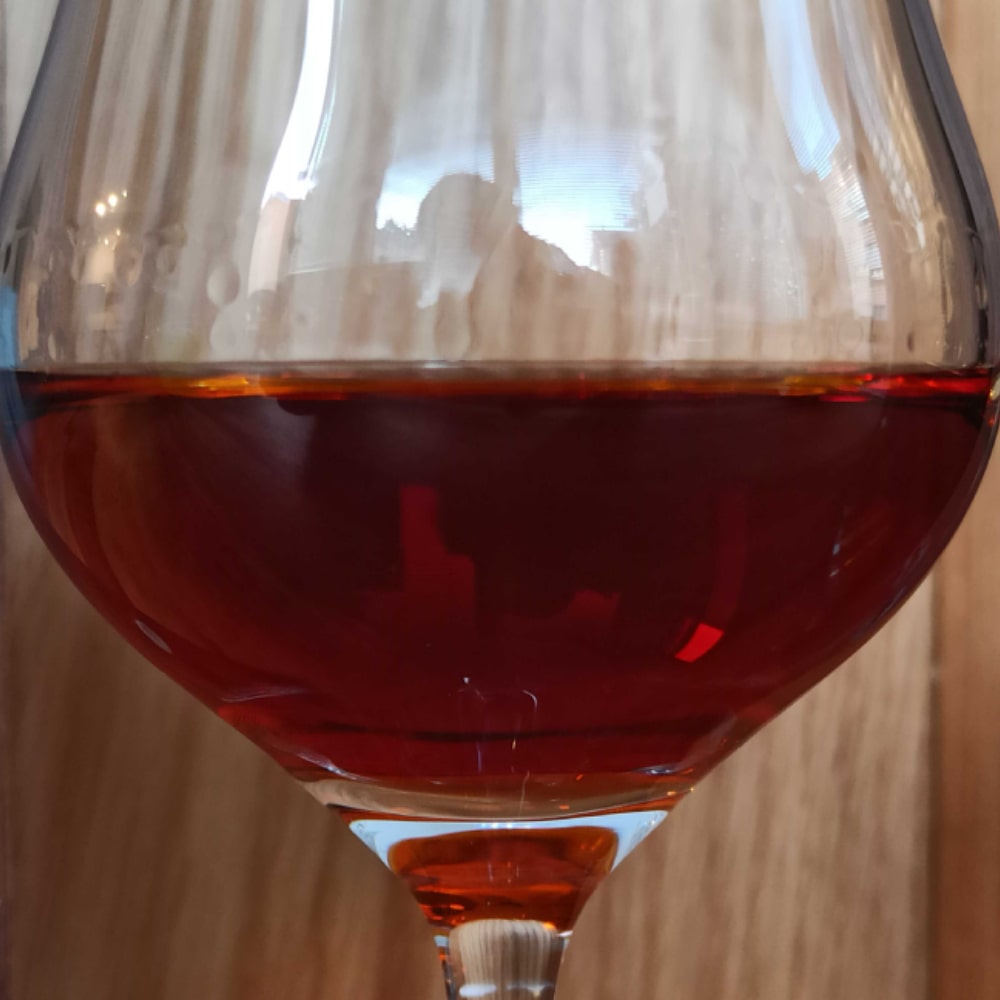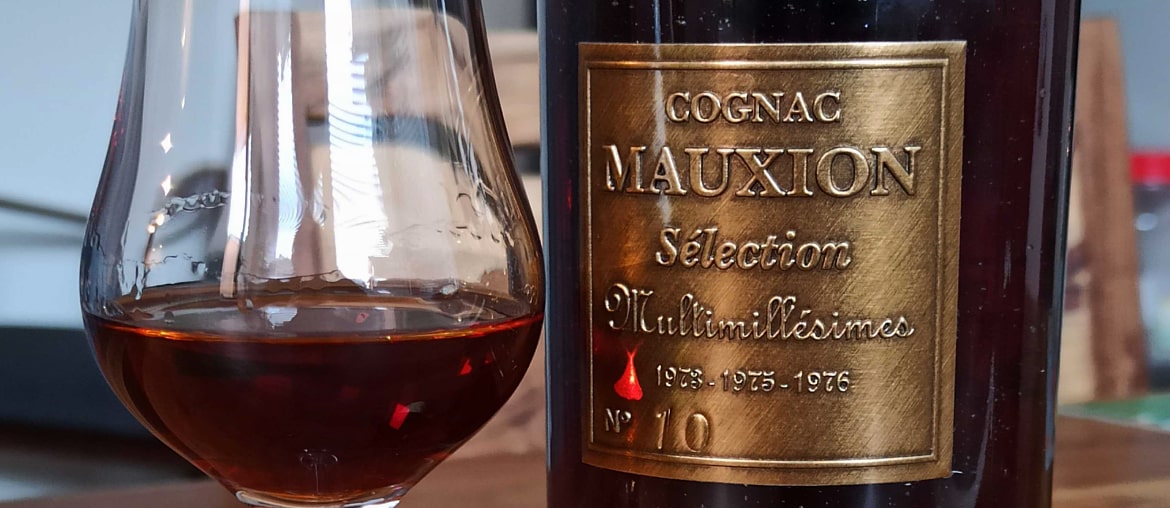On my table and in my glass this month is the Mauxion Sélection Bons Bois Multimillésime 1973-1975-1976. The Cognac is from a single barrel – more on that later – and was bottled in May 2021 with natural color and at cask strength, that is 49.5% alcohol. Needless to say, these product details are all quite agreeable. Looking at the wood box, the antique-style bottle with trapped air bubbles, the wax cap, and the brooding dark color, I feel a sense of intrigue by all that’s in front of me. Before even diving in, I expect a Cognac that is true, intense, rustic perhaps, demanding perhaps, and certainly memorable in one way or another.

Bons Bois Cognacs also capture my attention. I can’t help but think that if a producer bottles a mature Bons Bois Cognac at cask strength, the eaux-de-vie inside must have characterful aromas, flavors, and sensations – a story to tell let’s say. I’d posit that many Cognac enthusiasts primarily search far and wide for mature Cognacs from the Grande and Petite Champagne crus. No one is wrong to do so. In fact, I suppose I’m guilty of this to some extent. But Grande Champagne, the often repeated Premier Cru of Cognac, is a name on paper. To be sure, eaux-de-vie from the Grande Champagne are likely the most apt to age the longest whilst still retaining their elegant aromas and chiseled flavor profiles. But being labeled as Cognac’s Premier Cru does not preclude the other crus from yielding qualitative, honest Cognacs. This really is no different from France’s other wine regions, for example Burgundy or Bordeaux. Is a village level Pommard pinot noir significantly inferior to a Vosne Romanee Premier Cru? No not really; it just has something else to say.
I have a soft spot for Bons Bois Cognacs since what ends up in the glass often carries with it dramatically different aromas, flavors, and mouthfeels than the other crus. And I have not yet met a Bons Bois Cognac that didn’t have a strong personality, especially when bottled at a mature age and brut de fût, cask strength.
Production Details
As mentioned above, this Mauxion Bons Bois Multimillésime contains Cognacs from three vintages: 1973, 1975, and 1976, all put into a single 300 liter barrel for an eventual bottling in May 2021. The exact proportions from the barrel are as follows: 56% from 1975, 41% from 1973, and 3% from 1976. Moreover, the included paper certificate states that each vintage was distilled in a small seven hectoliter (700 liter) pot still. For reference, note that today’s typical Cognac pot still capacity is twenty five hectoliters (2 500 liters) – quite a size difference there. To save space in the cellar, the distiller – not Mauxion themselves -racked the three eaux-de-vie into one single 300 liter barrel. This single barrel then aged in a natural clay cellar until Mauxion obtained the barrel and proceeded with bottling this year.

Lastly, it’s worth repeating, the Cognac was bottled unchillfiltered, with natural color, at 49.5% alcohol, cask strength. It is a pure Bons Bois Cognac, and simple math indicates a minimum age of 45 years old.
Bottle Presentation & Packaging
It must be said that Mauxion’s packaging for transport is perhaps the most carefully thought out and most secure I’ve experienced with a bottle shipped to my front door. It may seem silly to write about this in what’s supposed to be a Cognac review, but bottles like this are high in value, so the Cognac can only be enjoyed if it arrives in one piece. The shipping parcel is quite voluminous and is stuffed with a fluffy but supportive cloth filler, not unlike the inside of a synthetic pillow. After sifting through this dense filler, the wooden box can only be reached after cutting through several layers of tight bubble wrap. Once the wood box is revealed and opened, the bottle inside is wrapped in more bubble wrap with an extra layer around the bottle’s waxed neck. Mauxion is clearly attentive to detail about the presentation of their Cognacs, and that includes how they are shipped to you.
The fragrant wood box is a nice touch and is on the level for a Cognac of this status. The box is rock solid in quality yet still exudes a natural simplicity. Once opened, the left side contains a rolled up paper certificate giving a short backstory on the Cognac. The information contained on the certificate states the age of the Cognac and provides the main details of production. In short, the certificate contains almost everything I would hope for on a back label. That being said, if Mauxion is going to take the effort to print and sign a paper certificate, why not also state the proportions of each vintage in the single multi-vintage barrel? To be clear, I’ve stated this info a few paragraphs above, but it is not actually found on the included certificate. It should be. To gather this information, I consulted the product page on the Cognac Expert shop. Still, good on Mauxion for providing meaningful information for the taster.

The bottle itself is basically the classic Charentais bottle, a shape I adore. However, the photos will reveal that the bottle has thousands of randomly scattered air bubbles trapped within its walls. It captures the look of a vintage mouth-blown glass bottle and all of its imperfections. The bottle has walls which seem thicker and more solid than your typical Charentais bottle, and there is a nice overall heft. It’s spot on since the bottle itself commands attention, but it remains quiet enough so as to not distract from the Cognac inside. In short, the bottle is elegant, simple, and rustic all at the same time.
This all leads me to the closure and wax seal. I cannot be the first person who’s received a beautiful Mauxion bottle only to glance at the bottle and sheepishly utter to myself, “Now how am I going to open this?” Perhaps no one wants to admit it publicly, but the question begs to be asked. The issue is not that there is wax; it’s the type of wax. This is dense, firm, and rock hard wax. The typical wax seal tricks didn’t get me very far. Tap with the butt of a knife to crack the wax – negative. Run the wax under hot water and slice through it like butter – dreaming. Use a corkscrew and treat it like a wax-sealed wine bottle – I did not do this and you should not either; there is a normal Cognac cork and plastic stopper underneath.
Moreover, does anyone really want to tap the neck of their new Mauxion bottle with the handle of a knife? Does anyone want to run that beautiful bottle under hot water to soften the wax? I’m afraid not. So what did I do? First, use your fingers to feel where the cork stopper meets the mouth of the glass bottle underneath. Then, I used my paring knife and cut at this top part of the wax in short upward motions (knife at 45 degree angle). Five minutes later, all was chipped away and the cut was flush with the mouth of the bottle. It looks good, but it’s time-consuming and unnecessarily stressful for a bottle presentation of this caliber.

Is the wax seal enough of a problem to hesitate obtaining a bottle? Honestly, no since the solution is perfectly manageable, just not obvious. But out of respect for the product, for Mauxion, and of course the customer, I feel compelled to raise the point. Mauxion, test out new waxes, or provide exact instructions for opening, or ditch the wax altogether.
It’s an appropriate time to taste some Cognac, since the above comments are details; the only thing that really matters is what’s in the glass.
Tasting Conditions
The tasting note and other commentary below were put together after tasting this Mauxion Bons Bois on seven different occasions. During each tasting, a control Cognac was tasted alongside to serve as a point of reference. In all honesty, though, the cask strength and strong personality of the Mauxion Bons Bois steamrolled the control Cognac and rendered it somewhat useless. Still, I almost always prefer to taste a new product for my palate next to something I taste frequently and know well. For glassware, I used the Lehmann Eau de Vie 15 glass, and I had my personally-adjusted Cognac Aroma Wheel printed out and by my side to aid in identifying which aromas and flavors I found to be present, and which were nonexistent. Lastly, each tasting session lasted roughly one hour. I make an effort not to rush since the smells and flavors can change dramatically over the course of one hour.
So let’s move on to the liquid in the glass.
Mauxion Multimillesime Tasting Notes
Eye: The Cognac pours a deep, dark copper color, with some bronze reflections and reddish tints. Coating the glass walls with the Cognac for the first time, I notice a thick disk that sets and refuses to cast legs. Legs will drop but patience is required.

Nose: Hovering my nose over the glass, I immediately smell freshly polished old wood furniture. There is an initial forceful presence from the wood. With a little time in the glass, black licorice arrives along with pine sap, leather belt, fine maple syrup, and Armagnac soaked raisins and prunes. With even more air time, a delicate nuttiness enters the scene. Finally, the nose as a whole comes off as quite roasted. This clearly noses as a Cognac, but it tiptoes into mature Armagnac and even sherry-bomb whisky territory. Still though, there is a structured spicy aspect of the woodiness that suggests this is firmly a Cognac. It’s quite a monstrous nose and a far departure from so many of the other delicate fruit-forward Cognacs I’ve tasted to date.

Palate: Intense spicy initial attack. It’s a mouthful. The first thing to note is the overall weight and density of the Cognac. It’s certainly full bodied and syrupy in texture, but the sheer force of the Cognac prevents it from feeling heavy or gloppy. Definitely be sure to take a small first sip to calibrate the palate; buckle up and enjoy the ride thereafter. It tastes of black licorice, chocolate fudge, medjool dates, maple syrup, dark fir honey (miel de sapin here in France), and various candied dark fruits. The Armagnac soaked fruits are there as well: cherries, raisins, and prunes. Vanilla is present but it takes a backseat to the other dark and brooding flavors. The Cognac clings to the teeth as it is swallowed, and as the finish approaches one feels a tannic bite, but with cushion thankfully. The pine sappy notes come towards the end. As expected, this is a Cognac of tremendous character. It successfully pulls off being charming and rustic simultaneously. This Mauxion Bons Bois is a take-no-prisoners, unapologetic flavor bomb.

Finish: The finish is of course long, but rustic and bittersweet. I’d also classify the finish as roaring. For my palate, a similar experience can be had by tasting Ardbeg 10: massive waves of flavor come pouring back a few seconds after the sip is down. The intensity of the experience is so high that I found myself tasting notes of this Cognac long after the tasting session. And at various moments after the tasting, I kept running my tongue over my teeth and actually got flavors from this Cognac. Seriously. There is an interesting contrast between the smells and the flavors into the finish. The aromas hint at something dessert-like and sweet, but the finish confirms this is anything but that. The underlying force from the wood provides a sturdy backbone and drives the Cognac forward with dry spice and dark candied fruit.
Conclusions
The Mauxion Bons Bois Mutlimillésime is quite an experience. Everything about this Cognac is high impact, and therefore memorable. Those who will consider purchasing this bottle must be comfortable with overproof spirits. One must be willingly looking for a Cognac that is not fruit-forward but that is spice and oak driven. One must consider that elegance and rusticity can coexist and not clash with each other. And finally, one must be comfortable with the fact this is most likely going to be quite different from many of the other Cognacs already on the drinks rack – take this from someone who has tremendous respect for a well-blended XO. For the cooler months headed our way, it’s a real killer!

Oh and one last thing: When you finish your glass, don’t rinse it; don’t clean it. Come back to it hours later, or even the next morning. Your nose will thank you. Head over the product page to learn more about the Mauxion Bons Bois Multimillésime.
Cheers.








2 Comments
25 hectoliter pot still is not as said 25’000 liters in capacity but 2’500 liters…
Olivier, thank you for pointing out my inadvertent error. I got careless with my zeros. To clear the record, a 25 hectoliter pot still has a 2500 liter capacity. Again, thank you.